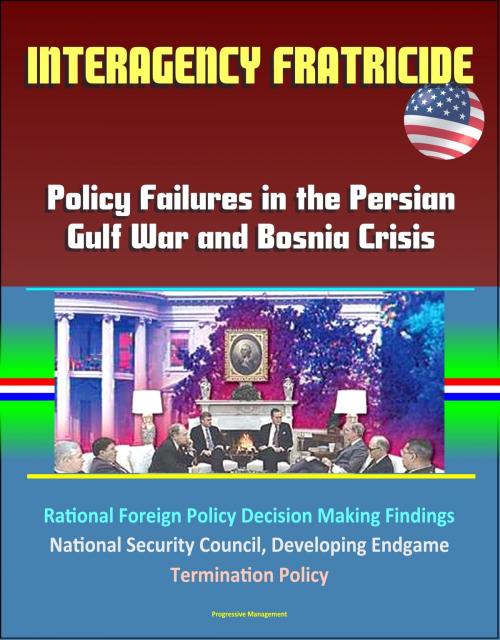Interagency Fratricide: Policy Failures in the Persian Gulf War and Bosnia Crisis - Rational Foreign Policy Decision Making Findings, National Security Council, Developing Endgame, Termination Policy
Nonfiction, History, Middle East, Persian Gulf War, Military, United States| Author: | Progressive Management | ISBN: | 9781370578689 |
| Publisher: | Progressive Management | Publication: | September 3, 2016 |
| Imprint: | Smashwords Edition | Language: | English |
| Author: | Progressive Management |
| ISBN: | 9781370578689 |
| Publisher: | Progressive Management |
| Publication: | September 3, 2016 |
| Imprint: | Smashwords Edition |
| Language: | English |
This excellent report has been professionally converted for accurate flowing-text e-book format reproduction. This fascinating work provides a comprehensive analysis of the factors that affected both interagency processes and policy outcomes during the Persian Gulf War (1990-91) and the early stages of the Bosnia crisis (1993-95). Going one-on-one with members of Washington's policy elite who were involved directly in these two cases, the author demonstrates that the US government's approach to termination policy proved fragmented and personality driven. She systematically presents evidence to support the study's conclusion, revealing that the nature of the gap between diplomats and war fighters will consistently produce policies that bring about cease-fire in the form of war termination, but fail to address the underlying causes and conditions that generated conflict (and, potentially, war). These issues must be resolved if the US government hopes to improve the social and political conditions of those embroiled in conflict while at the same time bolstering a security posture favorable to US interests in the aftermath of intervention. The three sections of this work thematically present the interagency process, the analysis and its findings, and implications for future termination policy development endeavors.
This book is the first of its kind. It integrates the real-world experiences of post-Cold War diplomats and war fighters, demonstrating that both need to think in more far-reaching terms regarding the development of conflict termination policy and the interagency's role therein. As Carl von Clausewitz says, this type of intellectual endeavor must be undertaken "before the first shot is fired." To accomplish this feat, policy makers must cast aside their institutional and individual personalities to determine what is best for those on whose behalf the United States intervenes—especially when the armed forces are called upon to act in the service of our country. I commend this work to you as a necessary first step in understanding interagency policy making. It's up to you to bridge the gaps between diplomats and war fighters toward creating effective conflict termination policy in the future.
PART I - Framing the Problem * Chapter 1 - Conflict Termination Within A Bureaucratic Environment * Interagency Decision Making via Negotiation * The Efficacy of the Policy-Making Process * Outline of the Study * Implications * Notes * Chapter 2 - Rational Choice Theory: Individual and Group Choice * Decision-Making Approaches: Units of Analysis as Delimiters * Rational Choice Theory * Groups as "Less than Rational" Actors * Rationale for Alternative Approaches * Notes * Chapter 3 - CONFLICT TERMINATION MODELS * Points or Processes? * Rational Actor Approaches * Summary * Notes * Chapter 4 - THE NATIONAL SECURITY COUNCIL SYSTEM * Allison's Bureaucratic Politics Approach * US Government Decision Making * National Security Policy Making * Building Toward New Understanding * Notes * Chapter 5 - INTERAGENCY FRATRICIDE: BRIDGING THE GAP BETWEEN THEORY AND PRACTICE * A Basic Conceptual Framework * Frameworks and Models * Indicators, the Hierarchical Model, and Data * Preliminary Conclusions * Complementary Analyses * Notes * PART II - Analysis and Findings * Chapter 6 - DYNAMIC THEMES: LEADERSHIP, NEGOTIATION, AND DOMESTIC POLITICS * Leadership * Organizational Culture * Communication Patterns * Personal Relations and Networking * Decision Making as Negotiation * Domestic Politics * Interpretation of Findings * Notes * Chapter 7 - CONTEXTUAL PARAMETERS: ENVIRONMENTAL FACTORS CHANNEL INTERAGENCY DYNAMICS * Strategic Vision and Planning Processes * Protection of Institutional Equities * Interpretation of Findings * Notes * CHAPTER 8 - CROSSCUTTING EFFECTS: ROLES AND MISSIONS AND MEDIA INFLUENCE * Clarity of Roles and Missions * Media Influence
This excellent report has been professionally converted for accurate flowing-text e-book format reproduction. This fascinating work provides a comprehensive analysis of the factors that affected both interagency processes and policy outcomes during the Persian Gulf War (1990-91) and the early stages of the Bosnia crisis (1993-95). Going one-on-one with members of Washington's policy elite who were involved directly in these two cases, the author demonstrates that the US government's approach to termination policy proved fragmented and personality driven. She systematically presents evidence to support the study's conclusion, revealing that the nature of the gap between diplomats and war fighters will consistently produce policies that bring about cease-fire in the form of war termination, but fail to address the underlying causes and conditions that generated conflict (and, potentially, war). These issues must be resolved if the US government hopes to improve the social and political conditions of those embroiled in conflict while at the same time bolstering a security posture favorable to US interests in the aftermath of intervention. The three sections of this work thematically present the interagency process, the analysis and its findings, and implications for future termination policy development endeavors.
This book is the first of its kind. It integrates the real-world experiences of post-Cold War diplomats and war fighters, demonstrating that both need to think in more far-reaching terms regarding the development of conflict termination policy and the interagency's role therein. As Carl von Clausewitz says, this type of intellectual endeavor must be undertaken "before the first shot is fired." To accomplish this feat, policy makers must cast aside their institutional and individual personalities to determine what is best for those on whose behalf the United States intervenes—especially when the armed forces are called upon to act in the service of our country. I commend this work to you as a necessary first step in understanding interagency policy making. It's up to you to bridge the gaps between diplomats and war fighters toward creating effective conflict termination policy in the future.
PART I - Framing the Problem * Chapter 1 - Conflict Termination Within A Bureaucratic Environment * Interagency Decision Making via Negotiation * The Efficacy of the Policy-Making Process * Outline of the Study * Implications * Notes * Chapter 2 - Rational Choice Theory: Individual and Group Choice * Decision-Making Approaches: Units of Analysis as Delimiters * Rational Choice Theory * Groups as "Less than Rational" Actors * Rationale for Alternative Approaches * Notes * Chapter 3 - CONFLICT TERMINATION MODELS * Points or Processes? * Rational Actor Approaches * Summary * Notes * Chapter 4 - THE NATIONAL SECURITY COUNCIL SYSTEM * Allison's Bureaucratic Politics Approach * US Government Decision Making * National Security Policy Making * Building Toward New Understanding * Notes * Chapter 5 - INTERAGENCY FRATRICIDE: BRIDGING THE GAP BETWEEN THEORY AND PRACTICE * A Basic Conceptual Framework * Frameworks and Models * Indicators, the Hierarchical Model, and Data * Preliminary Conclusions * Complementary Analyses * Notes * PART II - Analysis and Findings * Chapter 6 - DYNAMIC THEMES: LEADERSHIP, NEGOTIATION, AND DOMESTIC POLITICS * Leadership * Organizational Culture * Communication Patterns * Personal Relations and Networking * Decision Making as Negotiation * Domestic Politics * Interpretation of Findings * Notes * Chapter 7 - CONTEXTUAL PARAMETERS: ENVIRONMENTAL FACTORS CHANNEL INTERAGENCY DYNAMICS * Strategic Vision and Planning Processes * Protection of Institutional Equities * Interpretation of Findings * Notes * CHAPTER 8 - CROSSCUTTING EFFECTS: ROLES AND MISSIONS AND MEDIA INFLUENCE * Clarity of Roles and Missions * Media Influence















